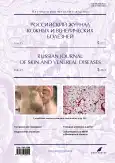Androgenic alopecia in men: the significance of genetic, hormonal and metabolic factors (prospective cohort comparative study)
- Authors: Kondrakhina I.N.1
-
Affiliations:
- State Research Center of Dermatovenereology and Cosmetology
- Issue: Vol 25, No 5 (2022)
- Pages: 349-361
- Section: DERMATOLOGY
- URL: https://journals.rcsi.science/1560-9588/article/view/233226
- DOI: https://doi.org/10.17816/dv112068
- ID: 233226
Cite item
Full Text
Abstract
BACKGROUND: diagnosis and treatment of androgenetic alopecia in male patients is a topical issue in modern dermatology, this is due to the high prevalence of this disease in the population, the complexity of the therapy. In most cases, the pathogenesis of this disease is associated with genetic factors, not paying attention to the totality of non-genetic factors that affect the occurrence and development of this disease in male patients.
AIM: to study the pathogenetic mechanisms of the occurrence and development of androgenic alopecia in men on the basis of a comprehensive account of genetic, hormonal and metabolic factors.
MATERIAL AND METHODS: Genetic predisposition to androgenic alopecia in male patients was evaluated by the method of minisequencing, evaluation of non–genetic factors ― using validated evaluation methods. Further finalizing of the research results was carried out using a neural network and step-by-step linear discriminate analysis.
RESULTS: The study included 50 male patients with a verified diagnosis of “Androgenic alopecia”, stages of the disease from I to IV on the Norwood-Hamilton scale, and 25 volunteers corresponding by age and nationality. The study of nucleotide polymorphisms made it possible to assess the potentially low and high level of genetic risk of this disease. The initial zinc level turned out to be significant for assessing the prognosis of the effectiveness of disease therapy. Mono- or polydeficiency of zinc, copper, magnesium, selenium, vitamins D, B12, E, folic acid play a significant role in the occurrence and development of the disease.
CONCLUSIONS: The results of the study show the different role of genetic and non-genetic factors in the occurrence and development of androgenic alopecia in male patients.
Full Text
##article.viewOnOriginalSite##About the authors
Irina N. Kondrakhina
State Research Center of Dermatovenereology and Cosmetology
Author for correspondence.
Email: kondrakhina77@gmail.com
ORCID iD: 0000-0003-3662-9954
SPIN-code: 8721-9424
MD, Cand. Sci. (Med.)
Russian Federation, 3/6 Korolenko str., Moscow, 107076References
- Randall VA. Molecular basis of androgenetic alopecia. Aging Hair. 2010. Р. 9–24. doi: 10.1007/978-3-642-02636-2_2
- Severi G, Sinclair R, Hopper JL, et al. Androgenetic alopecia in men aged 40–69 years: prevalence and risk factors. Br J Dermatol. 2003;149(6):1207–1213. doi: 10.1111/j.1365-2133.2003.05565.x
- Araviyskaya ER, Mikheev GN, Moshkalova IA, Sokolovsky EV. Baldness. Differential diagnosis. Methods of therapy. Saint-Petersburg: SOTIS; 2003. 86 p. (In Russ).
- Pirastu N, Joshi PK, deVries PS, et al. GWAS for male-pattern baldness identifies 71 susceptibility loci explaining 38% of the risk. Nat Commun. 2017;8(1):1584. doi: 10.1038/s41467-017-01490-8
- Rinaldi S, Bussa M, Mascaro A. Update on the treatment of androgenetic alopecia. Eur Rev Med Pharmacol Sci. 2016;20(1):54–58.
- Marcińska M, Pośpiech E, Abidi S, et al. Evaluation of DNA variants associated with androgenetic alopecia and their potential to predict male pattern baldness. PLoS One. 2015;10(5):e0127852. doi: 10.1371/journal.pone.0127852
- Lolli F, Pallotti F, Rossi A, et al. Androgenetic alopecia: a review. Endocrine. 2017; 57(1):9–17. doi: 10.1007/s12020-017-1280-y
- Prie BE, Iosif L, Tivig I, et al. Oxidative stress in androgenetic alopecia. J Med Life. 2016;9(1):79–83.
- Upton JH, Hannen RF, Bahta AW, et al. Oxidative stress-associated senescence in dermal papilla cells of men with androgenetic alopecia. J Invest Dermatol. 2015;135(5):1244–1252. doi: 10.1038/jid.2015.28
- Sánchez P, Serrano-Falcón C, Torres JM, et al. 5α-Reductase isozymes and aromatase mRNA levels in plucked hair from young women with female pattern hair loss. Arch Dermatol Res. 2018;310(1):77–83. doi: 10.1007/s00403-017-1798-0
- Jin W, Zheng H, Shan B, Wu Y. Changes of serum trace elements level in patients with alopecia areata: A meta-analysis. J Dermatol. 2017;44(5):588–591. doi: 10.1111/1346-8138.13705
- Fawzi MM, Mahmoud SB, Ahmed SF, et al. Assessment of vitamin D receptors in alopecia areata and androgenetic alopecia. J Cosmet Dermatol. 2016;15(4):318–323. doi: 10.1111/jocd.12224
- Mahmood L. The metabolic processes of folic acid and Vitamin B12 deficiency. J Health Res Rev. 2014;1(1):5−9. doi: 10.4103/2394-2010.143318
- Lie C, Liew CF, Oon HH. Alopecia and the metabolic syndrome. Clin Dermatol. 2018;36(1):54–61. doi: 10.1016/j.clindermatol.2017.09.009
- Chakrabarty S, Hariharan R, Gowda D, Suresh H. Association of premature androgenetic alopecia and metabolic syndrome in a young Indian population. Int J Trichology. 2014;6(2):50–53. doi: 10.4103/0974-7753.138586
Supplementary files









